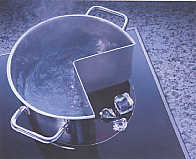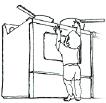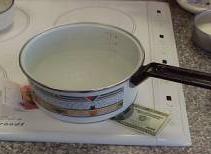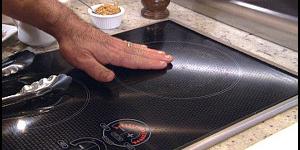Favorable:
Instant Adjustment
To serious cooks, the most important favorable point about induction cookers--given that they are as or more "powerful" at heating as any other sort--is that you can adjust the cooking heat instantly and with great precision. Before induction, good cooks, including all professionals, overwhelmingly preferred gas to all other forms of electric cooking for one reason: the substantial "inertia" in ordinary electric cookers--when you adjust the heat setting, the element (coil, halogen heater, whatever) only slowly starts to increase or decrease its temperature. With gas, when you adjust the element setting, the energy flow adjusts instantly.
But with induction cooking the heat level is every bit as instantaneous--and as exact--as with gas, yet with none of the many drawbacks of gas (which we will detail later). Induction elements can be adjusted to increments as fine as the cooker maker cares to supply, just like gas, and--again very important to serious cooks--such elements can run at as low a cooking-heat level as wanted for gentle simmering and suchlike (something even gas is not always good at). Someday, perhaps not so many years away, the world will look back on cooking with gas as we today look on cooking over a coal-burning kitchen stove.
No Wasted Heat

With induction cooking, energy is supplied directly to the cooking vessel by the magnetic field; thus, almost all of the source energy gets transferred to that vessel. With gas or conventional electric cookers (including halogen), the energy is first converted to heat and only then directed to the cooking vessel--with a lot of that heat going to waste heating up your kitchen (and you) instead of heating up your food. (The striking image at the left shows how precisely focussed heat generation is with induction--ice remains unmelted on an induction element that is boiling water!)
As a comparison, 40%--less than half--of the energy in gas gets used to cook, whereas with induction 84% percent of the energy in the electricity used gets used to cook (and the rest is not waste heat as it is with gas). There are two important heat-related consequences of that fact:
-

cooler kitchens: of course the cooking vessel and the food itself will radiate some of their heat into the cooking area--but compared to gas or other forms of electrically powered cooking, induction makes for a much cooler kitchen (recall the old saying: "If you can't stand the heat, get out of the kitchen."); and,
a cool stovetop: that's right! The stovetop itself barely gets warm except directly under the cooking vessel (and that only from such heat as the cooking vessel bottom transfers). No more burned fingers, no more baked-on spills, no more danger with children around. (The photo at the right--one of several similar ones to be found on the web--shows, like the one above, how only the cooking vessel does the actual cooking.)
Safety


We have already mentioned that the stovetop stays cool: that means no burned fingers or hands, for you or--especially--for any small children in the household. (In the image at the right, you can see a pot boiling water on an induction unit while a dollar bill between the pot and the cooktop surface is unsinged.) And for kitchens that need to take into account special needs, such as wheelchair access, nothing, but nothing, can beat induction for both safety and convenience (see the paragraph farther below).  Furthermore, because its energy is transferred only to relatively massive magnetic materials, you can turn an induction element to "maximum" and place your hand flat over it with no consequences whatever--it will not roast your non-ferrous hand! (Nor any rings or bracelets--the units all have sensors that detect how much ferrous metal is in the area that the magnetic field would occupy, and if it isn't at least as much as a small pot, they don't turn on.) And, while an element is actually working, all of its energy goes into the metal cooking vessel right over it--there is none left "floating around" to heat up anything else. (The image at the left shows a hand--wearing a metal ring--harmlessly touching a full-on induction element, while a metal utensil lies equally harmlessly on another, emphatically demonstrating those points.)
Furthermore, because its energy is transferred only to relatively massive magnetic materials, you can turn an induction element to "maximum" and place your hand flat over it with no consequences whatever--it will not roast your non-ferrous hand! (Nor any rings or bracelets--the units all have sensors that detect how much ferrous metal is in the area that the magnetic field would occupy, and if it isn't at least as much as a small pot, they don't turn on.) And, while an element is actually working, all of its energy goes into the metal cooking vessel right over it--there is none left "floating around" to heat up anything else. (The image at the left shows a hand--wearing a metal ring--harmlessly touching a full-on induction element, while a metal utensil lies equally harmlessly on another, emphatically demonstrating those points.)
 Moreover, gas--induction's only real competition--has special risks of its own, not all of which are as well known as they perhaps should be. While the risk of a gas flame, even a pilot light, blowing out and allowing gas to escape into the house is relatively small, it does exist. But a much bigger concern is simply gas itself, even when everything is working "right". Use any web search engine and enter the terms gas health risk cooking and see what you find (really: do try it right here); if, for example, you visit the Gascape web site, you may never again want to even enter a house with gas laid on (take some time to really poke around on this site--you may be shocked). And, of course, all combustion releases toxic carbon monoxide.
Moreover, gas--induction's only real competition--has special risks of its own, not all of which are as well known as they perhaps should be. While the risk of a gas flame, even a pilot light, blowing out and allowing gas to escape into the house is relatively small, it does exist. But a much bigger concern is simply gas itself, even when everything is working "right". Use any web search engine and enter the terms gas health risk cooking and see what you find (really: do try it right here); if, for example, you visit the Gascape web site, you may never again want to even enter a house with gas laid on (take some time to really poke around on this site--you may be shocked). And, of course, all combustion releases toxic carbon monoxide.
Ease and Adaptability of Installation

Unlike most other types of cooking equipment, induction units are typically very thin in the vertical, often requiring not over two inches of depth below the countertop surface. When a cooking area is to be designed to allow wheelchair access, induction makes the matter simple and convenient. (In the image at the left, notice how the induction cooktop is scarcely any thicker than the actual countertop.)
Ubiquity

It is an obvious but still very important fact that induction cookers are powered by electricity. Not every home actually has a gas pipeline available to it--for many, the only "gas" option is propane, with the corollary (and ugly, space-taking, potentially hazardous) propane tank and regular truck visits. But everyone has clean, silent, ever-present electricity.
Cleanliness

Burning gas has byproducts that are vaporized, but eventually condense on a surface somewhere in the vicinity of the cooktop. Electrical cooking of any kinds eliminates such byproducts.
Unfavorable:
The Cooking Vessels
The most obvious and famous drawback to induction cooking has already been mentioned: it only works with cooking vessels made of magnetic materials. The commonest such materials used for cooking vessels are stainless steel and cast iron. Cookware suited for use with induction cookers, from the extreme high-quality end down to thrift-store modest, is readily available; but if you already have a stock of mostly expensive aluminum or copper or glass or pyrex cookware and little or no cast iron or stainless, you might be up for a cookware investment.
On the other hand, if you have a significant quantity of non-ferrous cookware that is not terribly expensive, you can replace it--possibly with much better stuff!--as part of the process; cast iron is by no means "spendy" cookware. If you have ever seen the inside of a real restaurant kitchen, you will surely have noticed that most or all of the cookware is either cast iron or nice, shiny stainless steel (even when they are still using gas for their cooking). Steel is most cooks' preferred cookware material for many good reasons we discuss elsewhere on this site (see the link below--and recall that enamelled steel cookware also works beautifully on induction.
(Note that not all stainless-steel cookware works equally well on induction units; much depends on how the maker has assembled the layers of metal of which the pot or pan is made. Do not assume that all cookware labelled "stainless steel" will work on an induction unit--but almost all makers whose products do work, which includes a lot, will proudly say so in their advertising material or specifications. The easiest test in the world is to take any magnet--a refrigerator-decor type works fine--and see if it will cling to the bottom of a piece of cookware. If it doesn't, or if it clings very weakly, that item of cookware will not work on an induction cooker. If you're shopping for cookware that you want to be able to use on an induction unit, now or in the future, just take such a magnet along with you. Or, if you're buying off the web, make sure the product description says the item is induction-compatible, or ask for a written or emailed statement that it is, with full refund privileges.)
As we noted elsewhere, technology to allow use of any metal cookware--even copper and aluminum--is in the pipeline, but there are definite problems with getting sufficient power levels with that technique, so it will likely be many years before units with it start showing up in the mainstream (if they ever do). So, for now, the need for ferric cookware does remain.

No comments:
Post a Comment